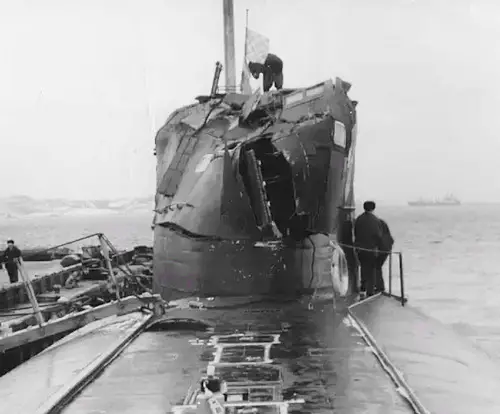In the early 1990s, the Russians say, the Russian Navy was faced with the vigorous activity of American nuclear-powered submarines in its coastal areas, primarily in the Barents Sea. The Russians term it as covert, “cowboy-style” aggressive, and especially dangerous – near points and along the deployment routes of nuclear multipurpose and strategic missile carriers.
In February 1992, in its attempt to covertly track, the USS Baton Rouge submarine (type Los Angeles) collided with a Russian submarine B-276 Kostroma of Project 945 (Sierra) near the Russian naval base of Severomorsk in the coastal region of the Barents Sea. This incident is also notable because it took place on the border of Russian territorial waters (12-mile zone). In the collision area were the routes of Russian submarines based in the Motovsky and Kola bays. The short detection range of the hydroacoustic systems, limited water area, intensive navigation and active manoeuvring, especially in the aggregate, dramatically increase the likelihood of such events.

The USS Grayling submarine (Sturgeon type) collided with the Russian strategic missile carrier Novomoskovsk (K-407) of Project 667 BDRM (Delta-4) in March 1993 in the Barents Sea due to a covert tracking attempt. Fortunately, like the previous one, there were no casualties in this incident. The Russian submarines received damage to their light hull and were repaired. However, had a collision between the Grayling and the K-407 occurred a few tens of seconds later, the American submarine would have rammed the missile compartment of the Russian submarine, damaging the silos and missiles in them. An explosion from a rocket fuel leak likely would have destroyed both submarines. Deep in the shallow Barents Sea, two boats would have unmuffled nuclear reactors and at least 64 nuclear warheads. It is unlikely that any of the crew members would have escaped.
As per the Russians, despite the end of the Cold War, American submarines continue to attempt to track Russian boats, putting them and Russians at unnecessary risk.
So, on 08/09/2014, the forces of the Northern Fleet of the Russian Navy discovered and evicted the newest multipurpose U.S. Navy fourth generation submarine of the “Virginia” type from the border waters of Russia. According to the Russian Navy, when the U.S. submarine was discovered, a naval anti-submarine group and an Il-38 anti-submarine aircraft were sent to displace it from the coastal region of the Barents Sea. Thanks to the coordinated work of the anti-submarine forces of the Northern Fleet, the American submarine was evicted out of the border waters of Russia. The anti-submarine operation lasted less than an hour, after which the American submarine, having lost its stealth, hastily left the Russian coastal waters.
In 2020, the U.S. Navy sent a Seawolf-class submarine to Norway to counter Russia’s growing influence in northern waters. The American submarine arrived from the Bangor base (Washington state) on August 21, 2020, in the Tromsø region (Norway). According to the U.S. Navy, the anti-submarine operations were to be conducted close to the routes of Russian submarine missile carriers. U.S. Submarine Force Commander Vice Adm. Daryl Caudle said at the time: “The Seawolf submarine deployment demonstrates the global reach of the submarine fleet and its willingness to maintain a permanent and discreet presence anywhere in the world for unique missions, while in a state of highest alert.”
Russia proposal to limit anti submarine activities
Considering the activities of the American submarines in the Russian coastal waters in the 90s, the Russians proposed to conclude a Treaty on the limitation of anti-submarine activities.
As per the Russians, the “cowboy” activities of American submarines near its shores were fraught with possible collisions between submarines, leading to their death and human casualties and catastrophic consequences for the environment.
A Russian-American agreement on the limitation of covert activities underwater would significantly add to the “Agreement on the Prevention of Incidents at Sea and in the Open Space Above It”, signed during the Cold War in 1972.
Such a move would have corresponded to increased mutual trust between the United States and Russia. The Maritime Doctrine of the Russian Federation (Approved by the President of the Russian Federation on July 26, 2015, No. Pr-1210) also aimed to resolve the issue of limiting hazardous activities in the Arctic regional direction.
However, the American side ignored the proposals.
The cost of a nuclear submarine accident
But this is only part of the problems that can cause the consequences of a nuclear submarine disaster. Carrying out complex rescue operations, disposal of a nuclear reactor, ensuring environmental safety, etc. – this is not a complete list of those areas of activity that may lead to accidents in submarines with nuclear power plants.
For example, about 120 companies from 20 countries were involved in raising the Kursk nuclear submarine after the disaster that occurred on August 12, 2000, in the Barents Sea! All stages of the operation were carried out throughout the year. The cost of the work was estimated at $ 130 million.
